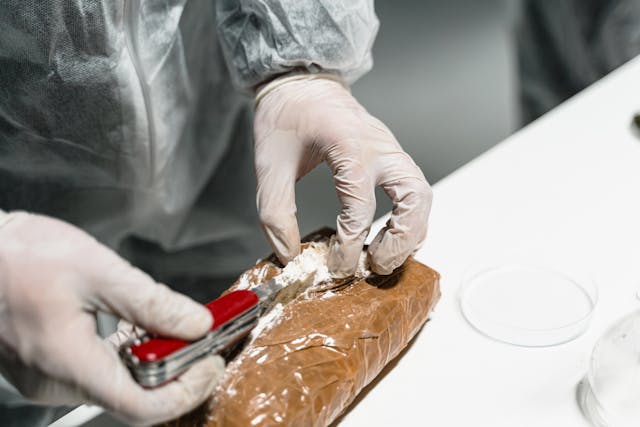
Is cocaine natural? The main ingredient in cocaine comes from a natural plant, but it needs to be processed.
Cocaine is a stimulant taken from the leaves of the coca plant. The Coca plant grows in South America, on the lower slopes of the Andes. Because it is such a valuable crop, cultivation has spread to areas where it wouldn’t naturally grow. The plants like hot, damp, and humid conditions. They are bushes that grow to about 2 or 3 m high and they have curved branches. Their leaves are thin, oval, and tapered. Currently, the Coca plant is grown in Argentina, Bolivia, Brazil, Colombia, Venezuela, Ecuador, Peru, Mexico, and Honduras.
Cocaine is processed before it is sold, but the leaves of the Coca plant can be chewed to release their effects. The Coca leaf is probably the oldest drug humans ever used. It is said that people in South America began to cultivate the drug over 8,000 years ago. Leaf fragments have been found in an area where Peru is today. The Coca leaf is actually very healthy and contains a lot of minerals, essential oils, People chewed the leaf as a stimulant and they also used it as a medicine. It has been used as an anesthetic for years. It is, however, addictive, so a lot of cultures restricted use to it. The Incas, for example, only used it during religious ceremonies. The leaves were believed to help with mood, improve digestion, and suppress appetites. The leaves only contain about 1% cocaine, so chewing the leaves is not as harmful or as addictive as powdered cocaine, but it can still be addictive.
Europeans encountered Coca leaves in South America when they arrived. The Spanish tried to ban it because of the effect it had, but they realized that the local people depended on it and they taxed it instead. The Spanish used it as a medicine and they took it back to Europe with them, although it didn’t become popular. It was only in the 19th century that a German chemist called Friedrich Gaedcke isolated the alkaloid. He called it erythroxyline. Then, in 1856, Friedrich Wohler, another German chemist, published the steps to isolate the alkaloid, and he called it cocaine. It became popular as an anesthetic because of its rapid numbing properties. Cocaine began to be seen as a healthy medicine and it was sold in drinks as well. John Pemberton’s Coca Cola is probably the most famous example.
As more people started to become addicted and the negative side of cocaine became obvious, there was a move to ban it. The newspapers got behind it and in 1914, cocaine was made illegal in the USA. Other countries followed closely behind. However, that didn’t stop the number of people that used it. Information from the US department of justice says that 28,000,000 people in the US have used cocaine at least once in their lifetimes. All of this cocaine has to come from South America and it is estimated that Colombia alone produces about $400 million of cocaine every week.
So, how is cocaine made? The leaves are picked off the bushes three times a year and they are shipped to be processed. The leaves are soaked and nitric acid is added before they are ground into a paste. Gasoline is added to the paste which causes a chemical reaction and creates a syrup. This syrups is squeezed through muslin until all the moisture has been removed. This is coca paste and it is between 30 and 90% pure cocaine. The next step is crystalizing the cocaine and this is done in specialized centers because it is a difficult process. Acetone is added to the paste to dissolve it, then hydrochloric acid is added. The hydrochloric acid crystalizes the cocaine and makes it rise out of the acetone, which can be discarded. The crystalized cocaine is then dried under heat lamps to make the white powder. The finished product is sold for a lot of money, although the farmers who grow the crop don’t get paid much. This is the same with opium and any other drug. Sometimes the cocaine is processed again to make crack cocaine. In this case, the powdered cocaine is boiled with water and baking soda. This removes the hydrochloride out of the cocaine, which causes the powder to become a solid substance. This substance can be broken up into rocks, which are then sold. It is called crack cocaine because it makes a cracking sound when it is smoked. Dealers use other chemicals as well to increase the quantity of the drug and to increase the effects. All of this means that crack cocaine is particularly dangerous. The natural leaves are still the safest and most natural form of cocaine. And this is what I learned today.
Photo by MART PRODUCTION: https://www.pexels.com/photo/white-powder-on-knife-7230833/
Sources
https://deserthopetreatment.com/stimulants/cocaine-addiction/how-its-made
https://en.wikipedia.org/wiki/Cocaine
https://en.wikipedia.org/wiki/Coca
https://www.tni.org/en/publication/coca-leaf-myths-and-reality
https://riveroakstreatment.com/cocaine-treatment/illegal-history-in-america
https://www.justice.gov/archive/ndic/pubs3/3951/3951p.pdf
https://recovered.org/stimulants/cocaine/how-cocaine-is-made
https://www.ojp.gov/pdffiles1/Digitization/132907NCJRS.pdf
